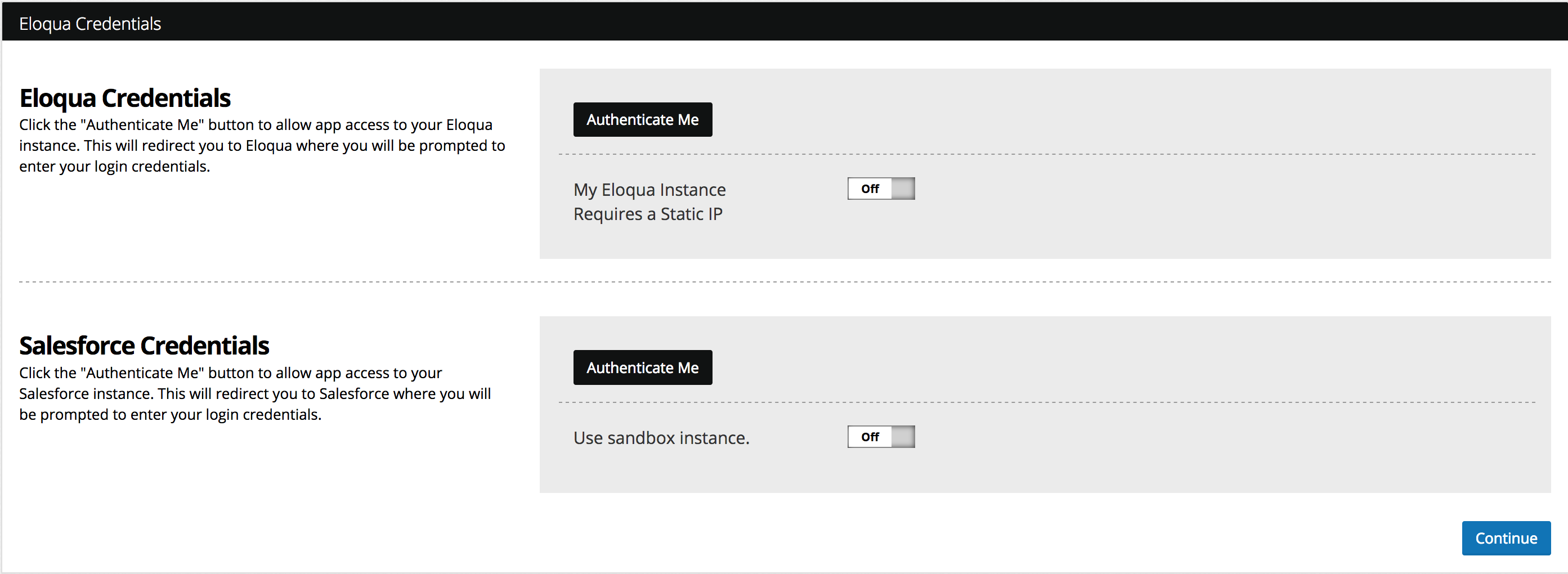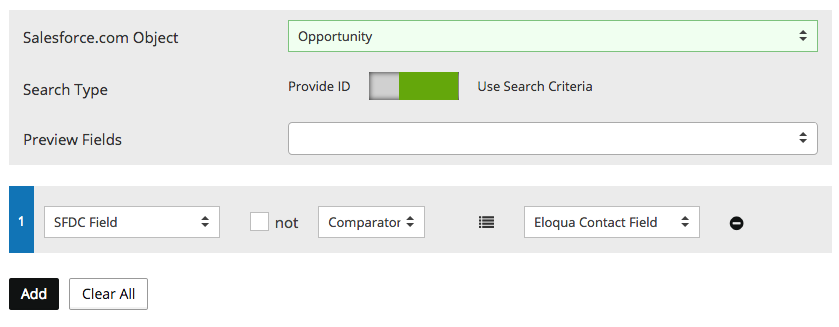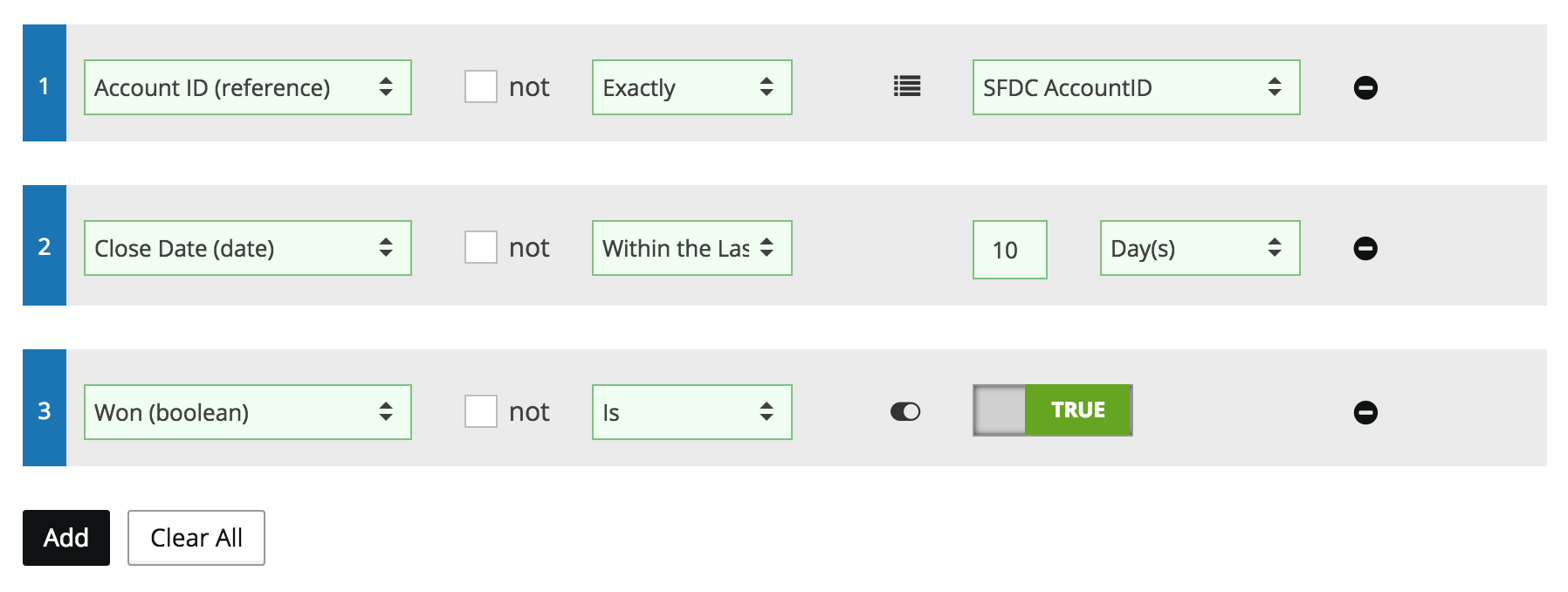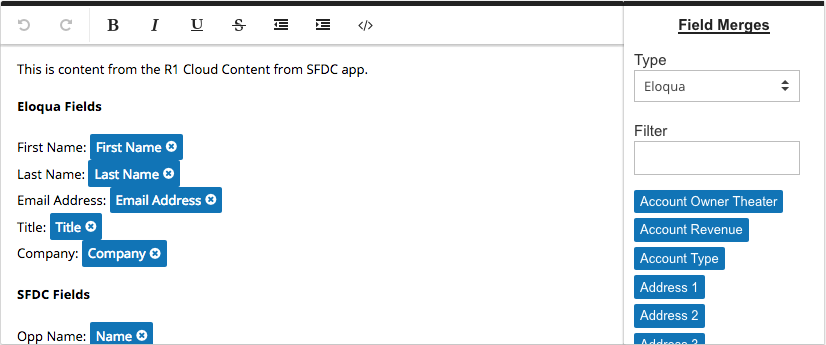Cloud Content for Salesforce.com
Oracle Marketing Cloud - Eloqua Campaign Enhancer
Subscription RequiredThe Cloud Content for Salesforce.com app is a premium app and requires a subscription. To see subscription options or to start a trial, visit our AppCloud. If you don't have an AppCloud account, you'll need to create one first...but no worries, this app may require a subscription but you can create an AppCloud account for free!
App Overview
The Cloud Content for Salesforce.com app allows you to create simple or complex queries for Eloqua Campaign Contacts to run against a Salesforce.com instance to personalize content in real-time. The app supports both Salesforce.com production and sandbox instances.
App Installation
To install the Relationship One Cloud Content for Salesforce.com app:
- Click on the install URL below:
IP AllowlistingIf you have Eloqua IP allowlisting enabled, please add AppCloud IPs to your allowlist - 44.236.213.84 and 44.238.209.213.
Please note, the installation process must be done by a user with Eloqua Customer Administrator rights.
-
Log into Eloqua with your Eloqua Credentials, if required.
-
Click Accept and Install to add the app to your Eloqua instance.
-
For your Eloqua credentials, click Authenticate Me to grant permission for the app to communicate with Eloqua on your behalf.

-
Click Accept or switch users to allow Eloqua to access the app.
-
For your Salesforce.com credentials, click Authenticate Me to grant permission for the app to communicate with Salesforce.com. You can choose to connect to either a production or sandbox instance.
-
Provide your Salesforce.com credentials and click Log In. Click Accept to allow the app to connect to Salesforce.com. Click Continue.
-
Select the Salesforce.com objects that can be used by the app. You can add as many standard and custom objects. To remove an object from the list, click the x.

- Click Save to finish the app installation process.
You will now see the Relationship One Cloud Content for Salesforce.com app in the App Catalog inside of your Eloqua instance.
The Relationship One Cloud Content for Salesforce.com app is now installed in the App Catalog inside of your Eloqua instance which can be found by clicking on Apps under the Settings menu in the Platform Extensions section. You can select the app to view the app description, modify the configuration settings, reinstall, or uninstall it. You can also check its status and dependencies.
App Configuration
Step 1: Add the Cloud Content to an Email
Add a Cloud Content element to your Eloqua email. For the older Eloqua email editor, double-click on the cloud content to configure. For the new responsive editor, click on the Configure button.
Step 2: Set a Salesforce.com Object
Select the “Salesforce.com Object” that will be used to populate content within your email.

Step 3: Select Search Type and Preview Fields
The Cloud Content for Salesforce.com app lets you personalize content from a single Salesforce.com record that all email recipients will receive or dynamically personalize content from different Salesforce.com records using search criteria.

Select "Provide ID" to specify a single Salesforce.com record.
When searching for records using a specific Salesforce.com ID, select "Provide ID" as your search type option and provide either the 15- or 18-digital Salesforce.com record ID number.

Select "Use Search Criteria" to dynamically personalize content using search criteria.
To search using search criteria, select the appropriate Salesforce.com field, the comparator, and Eloqua Contact field. (Note: you must select the comparator before choosing your Eloqua Contact field; available fields are context-sensitive.) Alternatively, you can use static fields by clicking on the icon (:fa-list:) next to the Eloqua field. To change it back, click on the icon once more. Keep in mind, the field options will be contextual to the Saleforce.com field type. The app supports the following field types:
- ID - Salesforce.com record ID of either 15 or 18 alphanumeric characters
- Reference - Salesforce.com reference record ID of either 15 or 18 alphanumeric characters
- Boolean - when using an Eloqua Contact field, provide the value that represents a "True" condition and a "False" condition. Click the (:fa-list:) icon to manual set the desired value.
- Currency - Salesforce.com currency field type
field value - Date - allows multiple comparator options including single dates, between two date fields/values, or within a specific date range
- Double - a numeric field value
- Datetime - specifies both the date and timestamp value. If not timestamp is specified, the default will be 00:00:00. When specifying a static value, select the date and then click on the clock icon to specify the desired time.
- String - a text field value
- Text Area - a large format field value
- Integer - a numeric value
- Picklist - allows searching for records using field values and various wildcard options
- Multipicklist - allows searching for records that include, excludes or has exactly one or more

To add a new decision criteria, click on the Add button. To remove all of the existing criteria and start over, click on the Clear All button.
If you have more than a single decision criterion, set the desired grouping logic. You can use a simple AND or OR logic or complex logic with custom syntax.

Simple AND or OR grouping logic.

Complex grouping logic syntax.
To test your search criteria, you will need to first select your preview fields. To select preview fields, put the cursor in the preview fields area and click to get of list of available Salesforce.com fields. Select the desired fields. To remove a field from the list, click the x

Step 4: Set Selection Criteria
In case more than one record is found, specify the rule that should be used.

Step 5: Test Your Criteria
Click the Preview Record button to retrieve the Salesforce.com record that meets your search criteria.

If you are using any Eloqua Contact record field merges, you will need to provide the email address of an Eloqua Contact before you can test your criteria.

Click the Continue button to continue.
Step 6: Create Your Message
Use the content editor to create your email content. You can personalize your content using both Eloqua and Salesforce.com field merge content.

Use the toolbar menu to change content formatting and spacing or to switch to the source code editor. When using with source code editor view, be careful to not modify field merge logic.

To add spaces or line returns before or after a field merge, click on a field and use the contextual toolbar. You can also drag fields around to the desired location.
To add field merges, select the Field Type, either Eloqua or Salesforce.com, and drag or double-click on the desired field. Use the Filter to search for a specific field. To remove a field from the content area, just click on the x.
Click the Save button to save your content edits.
Your Cloud Content has now been configured and is ready for use. You can close the app configuration window by clicking the X in the upper right corner.
The Cloud Content will automatically enable when you activate the Campaign and members enter in an Email action step.
Updated about 1 year ago
